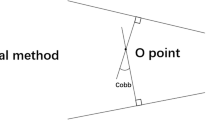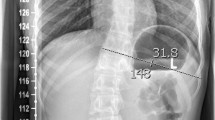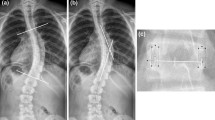Abstract
Purpose
The purpose of this study was to compare Cobb angle measurements performed using an Oxford Cobbmeter and digital Cobbmeter in a series of 20 adolescent idiopathic scoliosis (AIS) patients.
Methods
Four observers measured major Cobb angles on 20 standing postero-anterior radiographs of AIS patients with both Oxford Cobbmeter and digital Cobbmeter (iPhone Cobbmeter Application). The measurements were repeated a week after the original measurements.
Results
The mean Cobb angle in this study was 43.6° ± 23.62°. The mean measurement time for an observer to measure the 20 Cobb angles was 24.9 min for the smart phone compared with 25.6 min for the Oxford Cobbmeter. The 95 % confidence interval for differences between smart phone and Oxford Cobbmeter measurements on the same radiograph was ±3.68°. The intra-observer variability of the smart phone is equivalent to the Oxford Cobbmeter. The 95 % confidence intervals for inter-observer error were ±5° and ±5.8° for the smart phone and Oxford Cobbmeter, respectively.
Conclusions
We conclude that the smart phone with integrated Tiltmeter and Cobbmeter application is an equivalent Cobb measurement tool to the Oxford Cobbmeter. The advantages of smart phone are the accuracy of determining the most inclined vertebrae and accordingly more precise Cobb angle measurement. The new smart phones with these integrated applications may be really helpful to the spine surgeons, especially in hospitals where PACS or Oxford Cobbmeter is not available.



Similar content being viewed by others
References
Cobb JR (1948) Outline for the study of scoliosis. Am Acad Orthop Surg Instr Course Lect 5:261–275
Facanha-Filho FA, Winter RB, Lonstein JE et al (2001) Measurement accuracy in congenital scoliosis. J Bone Joint Surg Am 83:42–45
Loder RT, Urquhart A, Steen H et al (1995) Variability in Cobb angle measurementsin children with congenital scoliosis. J Bone Joint Surg Br 77:768–770
Loder RT, Spiegel D, Gutknecht S et al (2004) The assessment of intraobserver and interobserver error in the measurement of non-congenital scoliosis in children ≤10 years of age. Spine 29:2548–2553
Carman DL, Browne RH, Birch JG (1990) Measurement of scoliosis and kyphosis radiographs: intraobserver and interobserver variation. J Bone Joint Surg Am 72:328–333
Cheung J, Wever DJ, Veldhuizen AG et al (2002) The reliability of quantitative analysis on digital images of the scoliotic spine. Eur Spine J 11:535–542
Dang NR, Moreau MJ, Hill DL et al (2005) Intra-observer reproducibility and interobserver reliability of the radiographic parameters in the Spinal Deformity Study Group’s AIS radiographic measurement manual. Spine 30:1064–1069
Dutton KE, Jones TJ, Slinger BS et al (1989) Reliability of the Cobb angle index derived by traditional and computer assisted methods. Australas Phys Eng Sci Med 12:16–23
Kuklo TR, Potter BK, Polly DW Jr et al (2005) Reliability analysis for manual adolescent idiopathic scoliosis measurements. Spine 30:444–454
Morrissy RT, Goldsmith GS, Hall EC et al (1990) Measurement of the Cobb angle on radiographs of patients who have scoliosis: evaluation of intrinsic error. J Bone Joint Surg Am 72:320–327
Oda M, Rauh S, Gregory PB et al (1982) The significance of roentgenographic measurement in scoliosis. J Pediatr Orthop 2:378–382
Shea KG, Stevens PM, Nelson M et al (1998) A comparison of manual versus computer-assisted radiographic measurement: intraobserver measurement variability for Cobb angles. Spine 23:551–555
Zmurko MG, Mooney JF, Podeszwa DA et al (2003) Inter- and intraobserver variance of Cobb angle measurements with digital radiographs. J Surg Orthop Adv 12:208–213
Shaw M, Adam CJ, Izatt MT et al (2012) Use of the iPhone for Cobb angle measurement in scoliosis. Eur Spine J 21:1062–1068
Lenke LG, Betz RR, Harms J et al (2001) Adolescent idiopathic scoliosis: a new classification to determine extent of spinalarthrodesis. J Bone Joint Surg Am 83:1169–1181
Bland JM, Altman DG (1986) Statistical methods for assessing agreement between two methods of clinical measurement. Lancet 1(8476):307–310
Bland JM, Altman DG (2003) Applying the right statistics:analyses of measurement studies. Ultrasound Obstet Gynecol 22:85–93
Qiao J, Liu Z, Xu L et al (2012) Reliability analysis of a smartphone-aided measurement method for the Cobb angle of scoliosis. J Spinal Disord Tech 25(4):E88–E92
Rosenfeldt MP, Harding IJ, Hauptfleisch JT et al (2005) A comparison of traditional protractor versus Oxford Cobbmeter radiographic measurement. Spine 30:440–443
Adam CJ, Izatt MT, Harvey JR et al (2005) Variability in Cobbangle measurements using reformatted computerized tomographyscans. Spine 30:1664–1669
Beekman CE, Hall V (1979) Variability of scoliosis measurement from spinal roentgenograms. Phys Ther 59:764–765
Author information
Authors and Affiliations
Corresponding author
Ethics declarations
Conflict of interest
All authors do not have any potential conflict of interest.
Rights and permissions
About this article
Cite this article
Allam, Y., El-Fiky, T., Farghally, M.Y. et al. Comparison between Oxford Cobbmeter and digital Cobbmeter for measurement of Cobb angle in adolescent idiopathic scoliosis. Eur Spine J 25, 444–449 (2016). https://doi.org/10.1007/s00586-015-4162-0
Received:
Revised:
Accepted:
Published:
Issue Date:
DOI: https://doi.org/10.1007/s00586-015-4162-0




